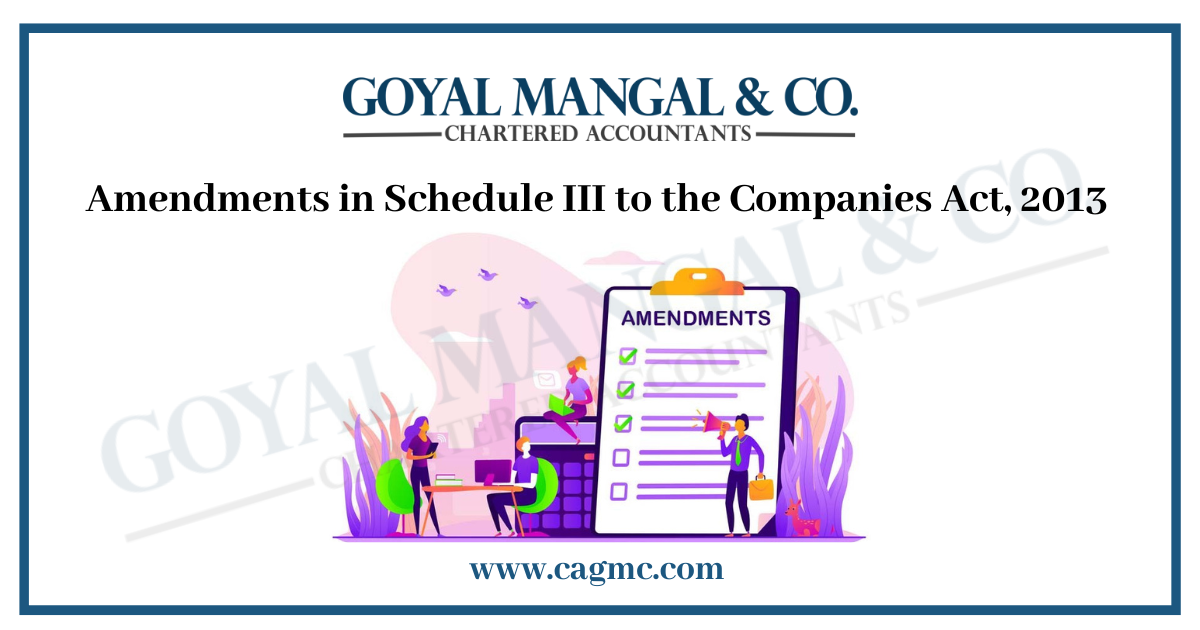 The Ministry of Corporate Affairs (MCA) on 11 October 2018 amended Schedule III of the Companies Act, 2013. Schedule III of the Companies Act, 2013 provides the format of financial statements of companies that comply with Accounting Standards (AS) and Ind AS under their Division I and Division II. Now Schedule III will apply to NBFCs covered by Ind AS. Let us have a look at the Synopsis of amendments in Schedule III to the Companies Act, 2013 FY 2021-22.
The Ministry of Corporate Affairs (MCA) on 11 October 2018 amended Schedule III of the Companies Act, 2013. Schedule III of the Companies Act, 2013 provides the format of financial statements of companies that comply with Accounting Standards (AS) and Ind AS under their Division I and Division II. Now Schedule III will apply to NBFCs covered by Ind AS. Let us have a look at the Synopsis of amendments in Schedule III to the Companies Act, 2013 FY 2021-22.
|
Table of Contents |
Amendments in Schedule III to the Companies Act, 2013
The MCA also amended the existing Division I (Indian GAAP) and Division II (Ind AS). Amendments to Schedule III Ind AS require additional disclosures from companies preparing Ind AS financial statements. Other disclosures reported relating to trade receivables, credit receivables, and trade payables also meet the disclosure requirements under the Micro, Small, and Medium Enterprises Development Act 2006.
A notable amendment is the insertion of Division III which prescribes the format for the preparation of the financial statements for non-banking finance companies (NBFCs) covered by the Ind AS.
Change of Division I
The amendments to Division I are minor changes and mostly relate to the wording used in an AS-compliant company’s balance sheet, such as replacing the word “Fixed Assets” under “Fixed Assets” with “Property, Plant, and Equipment”.
Change of Division II
Several changes have been made for Ind AS-compliant companies. Below are the amendments that have been submitted to Ind AS-compliant companies to the preparation and presentation of their financial statements:
- The “Equity and liabilities” item will show trade liabilities to micro and small enterprises and non-micro and small enterprises on the balance sheet.
- “Equity” – A description of each reserve on the balance sheet under “Equity” must be included in the notes to the financial statements. The report may include the purpose of each reserve, the reason for the movement of reserves during the year, etc.
- Non-current and current trade receivables are further divided into:
- Trade receivables are considered good–secured.
- Trade receivables are considered good–unsecured.
- Trade receivables have a significant increase in credit risk.
- Trade receivables–credit impairment.
The former classification of long-term and short-term trade receivables was as follows:
- secured, considered good
- unsecured, considered good
- doubtful
Below are the additional disclosures to be made regarding SMEs:
- Amount of principal and interest thereon remaining unpaid at the end of the financial year.
- The amount of interest paid under Section 16 of the Micro, Small and Medium Enterprises Development Act, 2006 (27 of 2006) together with the amount paid to suppliers beyond the specified date during each accounting year.
- The amount of interest that is due and payable for the period of default (which has been paid but after a date set during the year) but without the addition of interest as defined under the Micro, Small and Medium Enterprises Development Act 2006
- Amount of accrued interest and the remaining unpaid amount at the end of each accounting year.
- The amount of additional interest payable in subsequent years as well, until such interest is paid to the small business, for non-recognition of deductible expenditure under Section 23 of the Act on the Development of Micro, Small and Medium Enterprises, 2006.
Change of Division III
Financial Statements for NBFCs whose financial statements are prepared under the Companies (Indian Accounting Standards) Rules, 2015.
General Instructions which Indian AS has to comply
NBFCs have to comply with Indian AS
- Every NBFC in the Companies (Indian Accounting Standards) (Amendment) Rules, 2016, i.e. companies to which Indian Accounting Standards apply, shall prepare financial statements under this Schedule or with such modifications as may be required in certain circumstances.
- If compliance with the Act and all accompanying regulations, instructions, and circulars issued by the regulator from time to time applicable to NBFCs require any change in treatment or disclosure including changes in financial statements or part thereof, the same should be done. The requirements of this document will remain unchanged. The only exception is the ability to report assets and liabilities under the classification of current, and non-current under the relevant Ind AS.
- In addition to what is stated in the financial statements, the Annex provides the following:
- Breakdown or description of the items reported in these statements.
- Information on items that do not meet the conditions for recognition in these statements.
- Each item in the Balance Sheet, Statement of Changes in Equity, and Statement of Profit and Loss will contain cross-references to any related information in the Notes.
- In preparing the Notes, there must be a balance between excessive detail that does not burden users of the financial statements and loss of important information due to aggregation.
The rounding of figures given in the financial statements will be as follows depending on the total income of the NBFC:
| Total income in rupees | Rounded off |
| Less than 100 million rupees | Rounded to hundreds, thousands, millions, or millions or their decimal places. |
| Rs 100 million or more | Rounded to hundreds, thousands, millions, or millions or their decimal places |
The unit of measurement must be used uniformly in the financial statements.
- The statements must include the corresponding amounts for all items shown in the previous accounting period for comparison purposes, except when the financial statements are drawn up for the first time after incorporation.
- The financial statements must include all “significant” items. “Material” refers to all items that may, individually or collectively, affect the economic decisions that users make based on the financial statements. Materiality depends on the size or nature of the item, or both, and is assessed on a case-by-case basis.
- The terms used in the Schedule shall have the same meanings assigned to them by Indian Accounting Standards.
- If any law and all accompanying regulations, directives, and circulars issued by the regulator from time to time applicable to NBFCs require any particular disclosures to be made in the separate financial statements, the same shall be made in addition to the disclosures under this Annexure.
- The preparation of NBFC statements under this plan may change the order of presentation of line items in the financial statements or the order of line items in order of liquidity, if appropriate to the operations of the NBFC.
- The Appendix sets out minimum disclosure requirements in the Statement of Changes in Equity for the Period, the Balance Sheet, the Statement of Profit or Loss for the Period, and the Appendix. The statement of cash flows will be prepared under the relevant Indian accounting standard.
Final words
The amendments in Annex III are effective from 1 April 2021. Companies must prepare to provide significant information about the new clauses in the financial statements. Companies may need to re-align their financial statement closure process (FSCP) and internal control over financial reporting to ensure that information and data relating to the new clauses are compiled correctly and on time to avoid last-minute financial statement preparation difficulties.


